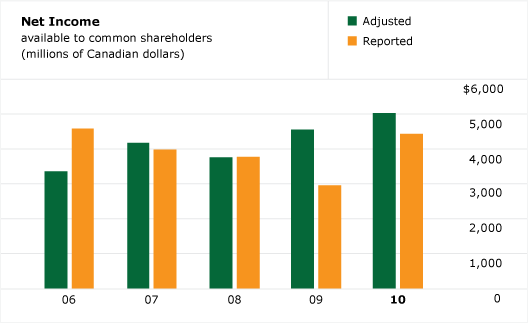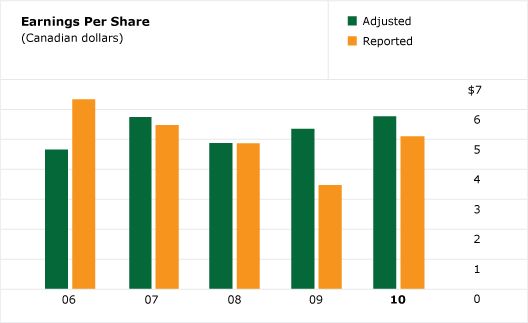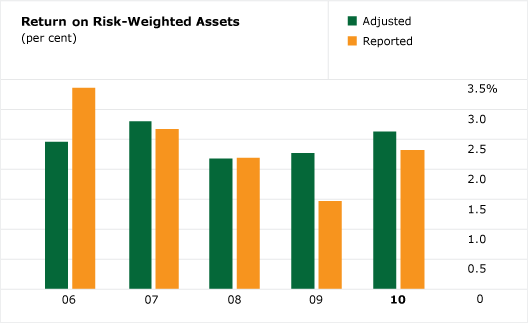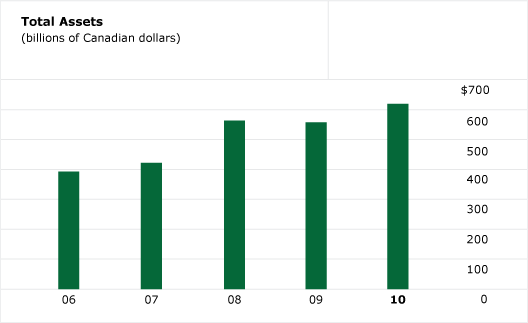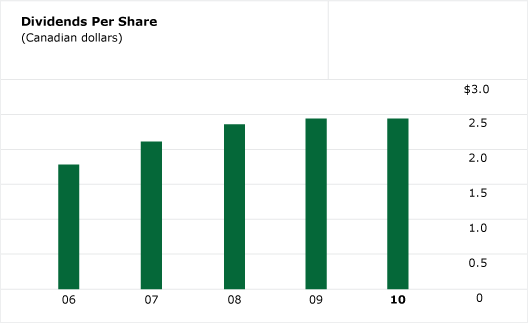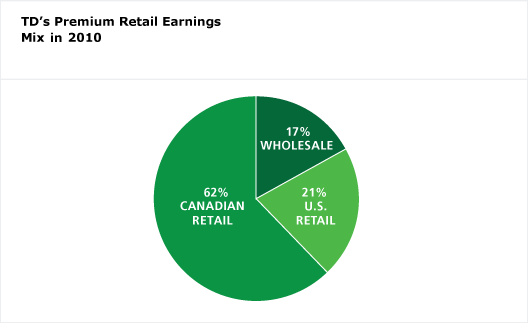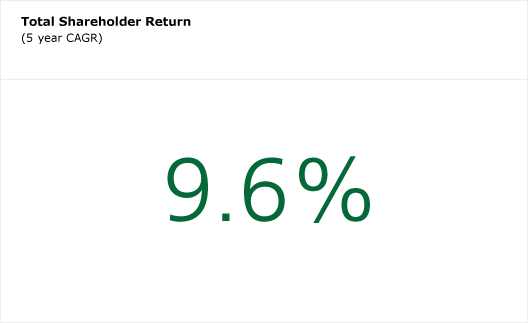Year at a glance

Message from our Chief Financial Officer
Overview
In 2010, despite the lingering economic challenges, our adjusted net income was $5.2 billion. Our results are a testament to the franchise earnings power of our retail businesses in both Canada and the U.S.
The highlights that follow tell a story of stability, strong leadership and growth, fuelled by our simple strategy – to produce long-term, profitable growth by building great franchises and delivering value to our customers, shareholders and communities.
-
2010 snapshot
Please see disclaimers for additional information.
-
Highlights
We’re proud of all we accomplished in business this year, from expanding our operational footprint to finding new ways to serve our customers and clients – and that’s just the beginning.
We’re proud of all we accomplished in business this year, from expanding our operational footprint to finding new ways to serve our customers and clients – and that’s just the beginning.
Launched our mobile banking application across North America
with more than 600,000 downloads
TD Bank, America’s Most Convenient Bank, grew its footprint by 23%
through organic growth and acquisitions
TD named Best Bank in North America
by Euromoney magazine for the second year in a row
TD Canada Trust announced the introduction of 7 day banking
to more than 300 branches in 90 communities across Canada
Our retail operations posted a record $4.8 billion
in adjusted earnings for 2010
TD Waterhouse launched a global trading platform
that provides direct online real-time access for clients to 10 leading European and Asia Pacific markets
TD Securities maintained its top 3 dealer status in Canada -
number 1 in M&A completed and equity block trading; number 2 in fixed income trading and underwriting
TD Insurance’s total premiums exceeded $3 billion -
number 2 personal home and auto insurer in Canada
TD Canada Trust named Highest in Customer Satisfaction
Among the Big Five Retail Banks for the 5th year in a row
Please see disclaimers for additional information.
-
Key financial metrics
A summary of our 2010 results and financial position tells TD’s high-level business story.
A summary of our 2010 results and financial position tells TD’s high-level business story.
(millions of Canadian dollars, except where noted) 2010 2009 2008 Results of operations Total revenues - reported $ 19,565 $ 17,860 $ 14,669 Total revenues - adjusted 19,562 18,621 14,372 Net income - reported 4,644 3,120 3,833 Net income - adjusted 5,228 4,716 3,813 Financial positions at year end Total assets 619,545 557,219 563,214 Total deposits 429,971 391,034 375,694 Total loans 272,329 255,496 221,160 Per common share (Canadian dollars) Diluted earnings - reported 5.10 3.47 4.87 Diluted earnings - adjusted 5.77 5.35 4.88 Dividend payout ratio - adjusted 42.1% 45.6% 49.3% Closing market price 73.45 61.68 56.92 Total shareholder return 23.3% 13.6% (17.1)% Financial ratios Tier 1 capital ratio 12.2% 11.3% 9.8% Total capital ratio 15.5% 14.9% 12.0% Efficiency ratio - reported 62.2% 68.4% 64.8% Efficiency ratio - adjusted 58.6% 59.2% 64.6% Please see disclaimers for additional information.
-
Performance indicators
Performance indicators focus effort, communicate our priorities and benchmark TD’s performance as we strive to be The Better Bank. The following table highlights our performance against these indicators in 2010.
Performance indicators focus effort, communicate our priorities and benchmark TD’s performance as we strive to be The Better Bank. The following table highlights our performance against these indicators in 2010.
2010 performance indicators Results1 Financial - Deliver above-peer-average total shareholder return2
- Grow earnings per share (EPS) by 7% to 10%
- Deliver above-peer-average return on risk-weighted assets
- TD return: 23.4% vs. Canadian peer average of 22.2%
- 8% EPS growth
- TD return: 2.63% vs. Canadian peer average of 1.98%
Business operations - Grow revenue faster than expenses
- Invest in core businesses to improve efficiency and effectiveness
- Revenue growth exceeded expense growth by 1%
- Refer to “Business Segment Analysis” in the MD&A for details
Customer - Focus on improving Customer Experience Index (CEI)3
- Invest in core businesses to enhance the customer experience
- CEI score 28.6% (target 25.5%)
- Refer to “Business Segment Analysis” in the MD&A for details
Employee - Improve employee engagement score year over year
- Enhance the employee experience by:
- Listening to our employees
- Building employment diversity
- Providing a healthy, safe and flexible work environment
- providing competitive pay, benefits and performance-based compensation
- investing in training and development
- Employee engagement score4 was 4.15 in fall 2010 vs. 4.11 in fall 2009
- See TD’s 2010 Corporate Responsibility Report available March 2011
- $56.3 million invested in fiscal 2010
Community - Donate minimum of 1% of domestic pre-tax profits (five-year average) to charitable and not-for-profit organizations
- Make positive contributions by:
- supporting employees’ community involvement and fundraising efforts
- supporting advancements in our areas of focus5, which include: education and financial literacy, creating opportunities for young people, creating opportunities for affordable housing, and the environment
- protecting and preserving the environment
- 1.4%, or $38.4 million, in donations and community sponsorships in Canada vs. 1.3%, or $37.0 million, in 2009
- US$19.8 million in donations and community sponsorships in the U.S. vs. US$20.0 million in 2009
- £90,919 in donations and community sponsorships in the U.K. vs. £74,216 in 2009
- $409,000 in domestic employee volunteer grants to 593 organizations (22% year-over-year increase in employees’ community involvement)
- $21.5 million, or 55.5% of our community giving, was directed to promote our areas of focus domestically
- In 2010, TD became the largest North American-based bank to be carbon neutral
- $3.5 million distributed to 970 community environmental projects through TD Friends of the Environment Foundation; an additional $3.4 million from TD‘s community giving budget was used to support environmental projects
1 Performance indicators that include an earnings component are based on TD’s full-year adjusted results (except as noted) as explained in “How the Bank Reports” in the MD&A. For peers, earnings have been adjusted on a comparable basis to exclude identified non-underlying items.
2 Total shareholder return is measured on a one-year basis from November 1, 2009, to October 31, 2010.
3 Customer Experience Index (CEI) replaces TD’s previous measure of customer satisfaction. CEI is a measurement program that tracks TD customers’ loyalty and advocacy.
4 Scale for employee engagement score is from one to five.
5 In fiscal 2010, our areas of focus were updated to reflect the findings of a global review of TD’s community giving strategy. Disclaimers
Results prepared in accordance with GAAP are referred to as “reported.” Adjusted results (excluding “items of note,” net of tax, from reported results) and related terms are not defined terms under GAAP and, therefore, may not be comparable to similar terms used by other issuers.
See “How the Bank Reports” in the Management’s Discussion and Analysis for further explanation, a list of the items of note and reconciliation of non-GAAP financial measures.
“Five-year CAGR” is the compound annual growth rate calculated from 2005 to 2010, on an adjusted basis.
“TD’s Premium Retail Earnings Mix” is based on adjusted results.
“Canadian Retail” earnings are the total adjusted earnings of the Canadian Personal and Commercial Banking and Wealth Management segments.
“U.S. Retail” earnings are the total adjusted earnings of the U.S. Personal and Commercial Banking segments.
Canadian peers/Big Five Retail Banks include Royal Bank of Canada, Scotiabank, Bank of Montreal and Canadian Imperial Bank of Commerce.
U.S. peers include Citigroup, Bank of America, J.P. Morgan, Wells Fargo, PNC Financial and U.S. Bancorp.
For purposes of comparison with U.S. peers, dividends per share five-year compound growth rate are calculated on a year-to-date basis from Q3 2005 to Q3 2010.




